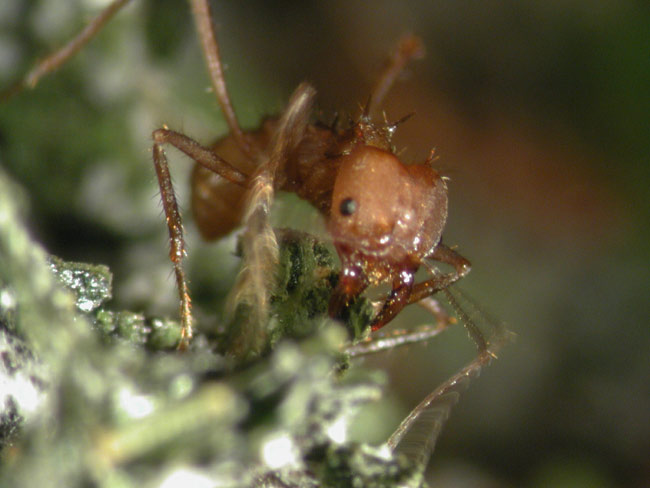Ants Use Antibiotics to Fight Pests

Fungus-gardening ants have the same problems as human farmers—crop-eating pests.
A new study shows that these ants enlist the help of antibiotic-producing bacteria to keep their gardens in order.
Panamanian attine ants cultivate large houses covered in fungus, which worker ants garden to provide food for the colony. But parasitic microfungi—of the genus Escovopsis—also have a taste for this food. Infected colonies experience a major falloff in garden growth rate and production of new workers.
Under some conditions, the pests can completely overgrow the fungus garden.
Fuzzy undersides
How ants deal with these parasitic pests was a puzzler until researchers peeled away fuzzy white clumps from the ants' undersides—between the head and first pair of legs—and uncovered tiny cavities. Inside each they found a trove of bacteria producing antibiotics that are deadly to garden pests.
"Within a colony, some workers have a very high abundance of the bacteria and it appears that these workers are specialized in dealing with infection," study author Cameron Currie of the University of Wisconsin-Madison told LiveScience.
Sign up for the Live Science daily newsletter now
Get the world’s most fascinating discoveries delivered straight to your inbox.
To keep the garden clean, the ants simply rub the bacteria, which they originally acquire from other workers, all over.
The ants spend most of the time in the parts of the garden where infections are highest, and since their bodies are covered in bacteria, the fungus and any other pests are in direct contact with the antibiotics, Currie added.
This service doesn't come free.
Researchers also noticed that the ants use special glands inside the cavities to produce food for the bacteria.
65-million-year-old question
The relationship between attine ants, bacteria, fungus, and pests originated some 50 to 65 million years ago, and has since been shaped by millions of years of co-evolution, scientists say.
As a result, specific groups of ants are specialized to cultivate specific groups of fungi; specific groups of fungi are hosts to specific groups of pests, and specific bacteria work against specific pests.
But this raises a question: Why haven't the parasites evolved resistance to the antibiotics? Many of the bacterial pests harmful to humans have become resistant to antibiotics over time, while apparently this microfungi have not. Determining how the bacteria have continually been able to produce antibiotics that stay a step ahead of the pests is the focus of the researchers' next study.
The research is published in the Jan. 6 issue of the journal Science.
- Amazing Ants Ambush Prey from Foxholes
- Fungus May Be Having Sex Among Us
- Hope for Eradicating Red Fire Ants
- Chocolate-loving Fungi









